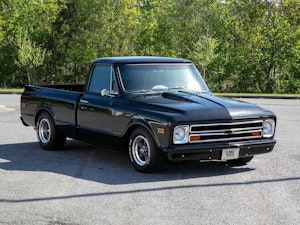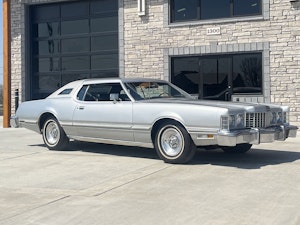Media | Articles
Deep dive into the 2020 Chevy Corvette’s chassis technology
Moving 500 pounds of V-8 engine 7.5-feet aft and 300 pounds of automatic transmission components 2.8-feet rearward yields a Corvette with very different weight distribution than ever before. Namely, rear wheels bearing 60 percent of the total curb weight. That, in turn, improves acceleration traction and shortens stopping distances with all four tires better able to provide their share of braking effort.
To achieve this makeover, the Corvette team redesigned the car’s structural spaceframe and created new steering, suspension, and braking components geared to the 2020 mission. Other than a few fasteners, no parts made the leap from the C7 to the C8.
Close examination of the new spaceframe reveals more frame and less space. Dozens of aluminum stampings, extrusions, hydroformed pieces, and castings are held together with fasteners and structural adhesive. What are affectionately known as the Bedford Six castings—they’re produced at a GM plant in Bedford, Indiana—have elaborate ribs, hollows, and interfaces that mate with adjoining frame members. One of their prime responsibilities is providing secure anchor points for the rear coil-over-damper assemblies.
One packaging issue that defied an elegant solution is the lack of clearance between the front of the engine and the cockpit’s firewall. To change one of the accessory drive belts, it’s necessary to drop the engine/transaxle package out the bottom of the car. Hopefully that egregious task won’t be necessary within the first 100,000 miles.
Marketplace
Buy and sell classics with confidence
20200220153703)
20200220153715)
The transverse buggy springs that Corvettes successfully employed for decades are long gone because the new transaxle has seized that space at the rear. Global chief engineer Tadge Juechter hated to see them go, he said, because they were such an outstanding weight-versus-cost solution. Once the single plastic rear spring was replaced by a pair of coil-over-damper units, it was necessary to follow suit at the front of the car to obtain consistent reactions to bumps and cornering inputs. The new packaging placed the rear coil-shock units above the tires, one reason why the C8’s center-of-gravity height has climbed slightly according to Car and Driver’s measurements.
To keep the total C7-to-C8 weight gain below 70 pounds—in spite of additions such as standard dry-sump engine lubrication, an additional gear in the transmission, and a roomier cabin—the parsimonious Juechter splurged a few dollars on ultralight components. The rear bumper beam is a hollow, curved tube manufactured by drawing resin-soaked carbon fibers through a die. Floor panels are fiberglass moldings topped by aluminum stampings to support the seats. The 10×50-inch flat panel that attaches to the bottom of the spaceframe’s central tunnel consists of three layers of fiberglass and two layers of carbon-fiber compression molded into a sandwich only 0.16 inches thick. That part, which is fastened to the aluminum tunnel with 30 screws, weighs only 4.9 pounds. (It’s likely that the large cavity above this panel will someday house lithium-ion batteries.) For the first time, the Corvette’s underbody is dead flat to trim aero drag. The new Corvette’s front and rear luggage bins are made of ultralight sheet molding compound (fiberglass) with a specific gravity below 1.0, which means they’d float if placed in water.
Suspension knuckles, control arms, and links are a fresh mix of aluminum forgings and castings. The magnetic-technology dampers with new suspension and body mounted accelerometer sensors are back as an $1895 option after the Z51 package has been selected.
20200220153622)
The new electrically assisted rack-and-pinion steering has a slightly quicker ratio (15.7:1) and fewer turns lock-to-lock (2.5) because the front wheels bear lighter loads. In addition, the rear suspension is tuned to diminish the chance of the tail swinging wide during aggressive turn-in. That annoying chatter experienced through the C7’s steering wheel during low-speed, full-lock maneuvers on cold days has been diminished, Juechter claims, by using less aggressive tire compounds with revised steering geometry.
Corvette and Michelin engineers spent five years tuning the new Corvette’s run-flat radials. The rear tire size has been increased to 305/30R-20 (up from 285/30R-20) and rear wheels are one inch wider to support the rearward weight shift. Pilot Sport ALS (all season) tires are standard while Pilot Sport 4S (summer) tires are part of the $5000 Z51 performance package.
Brake rotors are a touch larger in diameter at both ends of the car in consideration of the added speed available for 2020. One feature missing from the new Corvette is the cross-drilling and slotting that is useful in flushing water from the friction surfaces during wet driving. Juechter explains that more rigorous federal standards limiting the amount of dust permitted from pad wear eliminated copper content from the new friction material recipe. As it turns out, the new material is less resistant to abrasion by drilled holes and slots, so they’re gone in C8. That’s not to say you won’t see them when carbon-ceramic brake rotors reappear on hotter Corvettes such as the Z06 planned for introduction in the near future.
Now that you’ve made friends with the new chassis, it should be clearer why the mid-engine gestation was so lengthy. Instead of hustling C8 out the gate with a flaw or two, Tadge Juechter’s engineers took the time to perfect every last detail. The Corvette faithful are in for the treat of their sports car lovin’ lives.
20200220153615)








20200220153628)
20200220153638)
20200220153645)
20200220153652)
20200220153658)
20200220153721)
20200220153728)

